SOMETIMES LIFE JUST FEELS LIKE A MOVIE, and in this case it was a science fiction film from the 1970s. The landscape west of Rochelle, Illinois was frozen, bleak, devoid of life or any sign that anything could grow here. I came upon a huge warehouse, a featureless white cube with no markings, the kind of place where blankness can conceal startling experiments going on inside. I stepped inside a blandly anonymous set of offices, and poked around until I made my contact inside. He escorted me to an area where we both put on disposable lab coats and hairnets. Suited up, we stood before the airlock, and it opened.

The door opened upon paradise on earth, or maybe California in a petri dish—a massive glass box, seven acres in size and a good three stories high, in which hundreds of thousands of tomatoes grew in perfectly symmetrical rows. Blindingly bright, a humid 80 degrees, it had the unnervingness of the unnaturally perfect, even though you could see that real earth was right under a thin layer of plastic sheeting. The geometric precision on such a huge scale, the saturated colors and the gleaming more-than-sunlight on a zero degree day all made it feel as if I were somewhere that wasn’t quite real.
But it’s as real as the tomatoes which we sampled a moment later, or the stores where the tomatoes end up—which in Chicago include Local Foods, Whole Foods and Jewel, as well as on the menus of local restaurants. MightyVine Tomatoes, as the company is known, is the project of Jim Murphy and Gary Lazarski, who were also involved in the launch of Local Foods (of which Murphy is chairman), working with Dutch companies who wanted to bring their hydroponic greenhouse technologies and specially bred varieties of tomatoes to America. The goal, which developed in synergy with the creation of Local Foods as a wholesaler and distributor, is to be able to offer a genuinely local tomato year-round within a short truck drive of several million consumers. Rochelle, an industrial town with good highway and rail connections, is straight south of Rockford and within a couple of hours of Chicago, Milwaukee, Madison and much of downstate Illinois, making it a pretty ideal place to plop down this space age tomato farm.
Gary Lazarski, MightyVine’s CEO, showed me around and talked at length about growing a better tomato, making local work year-round in the midwest, and what it means to grow a local product that never actually touches soil (it grows in what can fairly be described as a kind of volcanic rock fuzz—more on that in a moment):
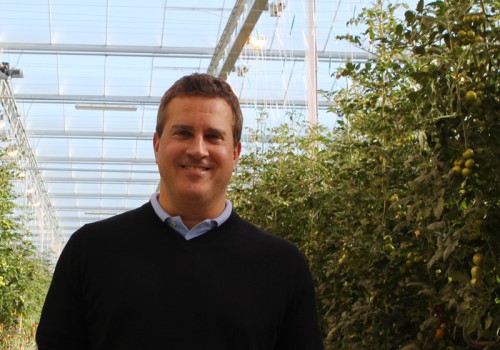
MightyVine CEO Gary Lazarski
FOODITOR: Tell me about this building we’re standing in.
GARY LAZARSKI: It’s seven and a half acres—about seven football fields. There’s about 30 people working in here—they’re down all the rows. We’re growing primarily two different varieties of tomatoes here; the one you see closest to us is called the Roterno, a tomato on the vine. We picked this variety because our partners in the Netherlands grow it. It has great flavor, and we’re very familiar with how it grows. And the other main one is the Robinio, a cherry tomato—that one eats like candy. In the summer, when the yield is greater, we might do 100,000 pounds a week. Right now we’re more like 70,000.
The greenhouse is about 27 feet in height. We have grow lights, diffused glass—you probably can’t see it, but there’s a coating that spreads the light; we probably wouldn’t have used it a couple of years ago, but now that solar has brought the cost of glass down, it’s become much more economically feasible. Greenhouse growers in the Netherlands, where they kind of test all these things out because it’s become such a mature industry, have found that it helps control the environment. Basically, everything is about trying to control the environment. If you asked any farmer what’s the one thing he wished he could control, he’d say weather, right? So we can make it 70 degrees and sunny in here in the middle of winter, which is how we’re able to grow tomatoes year-round.
How do you grow tomatoes in a facility like this?
We start by sending the seeds to a propagator, who happens to be in Canada. They grow them to a foot high, because that’s a different operation, a different kind of greenhouse. They come in here in these little blocks—
[He opens a block that the roots go into, exposing something that looks like gray fiberglass insulation.]
This is the grow medium. It holds just the right amount of water. If there’s too much, it falls out a hole in the back of the bag into gutters, pitched slightly to each end. That water runs and it’s recaptured. Same thing with the rainwater and snowmelt on the roof. If you’ve got snow and the next day it’s sunny, you’re not going to get the sun because there’s a foot of snow on the roof, so the heat from the lamps radiates against the glass and the snow and ice melts, gets captured in gutters—it’s kept in a basin on the northwest side of the building. We filter it with UV filtration, put in the manganese and the iron and all the other things the plants need to survive, and it goes through drip irrigation into the grow medium.
The medium, believe it or not, is spun from volcanic basalt, it’s called rock wool or stone wool, those are the trade names for it. These tomatoes can’t be considered organic, because it’s an inert medium—it doesn’t react with things. Organic has to grow in an organic medium, like dirt or cocoa peat. For us, the inertness is a benefit, because it doesn’t react with anything—and in a greenhouse, you don’t want to have any kinds of organic interactions that you can’t control.
So the roots take purchase in there, and then everything is supported on this truss system. You see the strings that are hanging up there? These things grow about a foot a week, and if they were going to last eight or ten months, continually putting out fruit, they’d grow through the roof. So the flowers are always on the top, doing photosynthesis. Every flower turns out fruit, you see the smaller fruit at the top, gradually getting larger, all the green fruit until you get to the red fruit at the bottom. As the plant grows up, you pull it lower, so that eventually you’ve got 30 feet of root bent around down there. The tomatoes are always at the same height, so that instead of field tomatoes where you’re bending down to pick them, they’re always at the right height for picking.
 Liam Gebert
Liam Gebert The rails you see going down each row serve a couple of purposes. You’ll see carts on them, simple carts for picking, or they might be scissor lifts for checking the tops, seeing how many flowers there are, seeing if there are any leaf diseases or anything like that. There’s a lot of scientific method involved but it’s also having a feel for it—Nic Helderman, our head grower, has been a grower for thirty years, his father was a grower, his grandfather was a grower—he’s got tomatoes in his blood.
If you asked any farmer what’s the one thing he wished he could control, he’d say weather, right? So we can make it 70 degrees and sunny in here in the middle of winter.
But the rails also radiate heat. We take water, heat it up in a boiler during the day, and then the CO2 captured from that process is piped into the greenhouse to help increase the yield, the carbon dioxide is absorbed by the plants and they put out oxygen, like you learned in biology class. That heated water goes into a tank like your hot water heater at home, and at night when the plants need it, it’s pumped into the pipes and that heat is radiated here.
Nic and his assistant grower Willem have a whole computer system with sensors all over the greenhouse, so they can maintain the right wind and temperature and so on even when it’s zero degrees out like it is today. Which is obviously some of the most challenging conditions. But as you can see, the windows are clear, the sun is shining, and we still have some of the lights on because even though it’s a clear and sunny day, the amount of energy that you’re getting from the sun in the winter is not going to be as much as you’d get in the summer.
Gallery: Inside Space Station Tomato
I see bees buzzing around. So I guess it’s not that sealed off from the world.
One of the things we do is integrated pest management. To the extent that we can, we control any pest that might destroy the tomatoes with their natural predators. Sometimes that’s ladybugs, they’re kind of like nature’s little destroyers, they eat other bugs but they don’t eat tomato leaves or tomatoes. Or other things like aphids or other bugs that will naturally occur in here—because in the summer we open the vents [in the roof], it’s not a scientific lab so you’re going to get bugs. That allows us to control the use of pesticides, or to eliminate the use of pesticides except in extreme cases.
Being in a closed environment like this, something could come up and we’d have to use a treatment, though so far we haven’t had to use anything. What we do to prevent that is to clean the greenhouse, we clear everything out and sanitize it and start over with a fresh crop. We’re probably going to do that this summer.
How did you get into the tomato greenhouse business?
The idea for this goes back maybe five or six years. Jim Murphy and I met some growers in Holland—we’d been traveling over there, looking at the technology. And I just became fascinated with the technology, yes, but mainly with the flavor of the tomatoes. From the time I ate one of their tomatoes, I had never had a tomato like that.
Growing up in Chicago, my grandmother came from Poland and she always had a garden. She would make apple pies when apples were in season, and she had the best tasting tomatoes, so I grew up with that—and then you hit a period when the food system became cellophane-wrapped, flavorless tomatoes. It didn’t used to be that way—our grandparents grew up with what we now call the local food movement. But after the interstates were put in place, it became more cost-effective to have giant farms on either coast, and just shipping things because fuel was cheap. Fuel’s still cheap, but what’s changed is that people like the taste of a good tomato or any other high quality item, and people like to know where it’s grown. They like to know they’re supporting local agriculture and the local economy.
At that time it was difficult to get anything financed, so we started doing Local Foods, and then Handcut Foods, which is a school foods service in the Local Foods facility. And with Local Foods in place, we kind of had a natural distributor for restaurants, and it gives Local Foods something to sell in the winter that they wouldn’t normally have. One of the things that Local Foods is changing, and that we’re trying to change at MightyVine, is to meet the demand from consumers who say, it doesn’t have to be that way, Chicago is a great food town, there’s no reason we can’t have a great tomato.
So how much of the tomato market does a facility like this represent?
In terms of the Chicago-Milwaukee-Madison market, 100,000 pounds of tomatoes a week is just a few percent of the weekly fresh tomato consumption. There’s fresh tomatoes and processed tomatoes; processed tomatoes are typically Roma tomatoes, that are grown in California or somewhere, mechanically harvested and processed. We’re not in that market, which is typically at a lower price point, a commodity market.
But for fresh tomatoes, like this, the reason that they’re typically so terrible in Chicago except for late summer when we get our own, locally grown tomatoes, is that they’re grown far away—whether that’s Mexico, or Florida, or California—shipped into the Chicago market, and then they’re kept in these ripening lockers. So they pick them when they’re green and hard, they sit in these ripening lockers and then they gas them with ethylene.
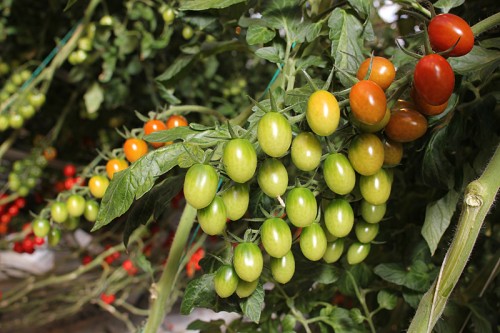
Grape tomatoes, another variety they’re testing
Ethylene is a naturally occurring gas that helps things ripen, but literally when you gas them like that, they turn from green to red overnight. That’s why when you look at them in the store, you say, Oh, that looks like a red tomato, but you cut into it and it’s just an orange, watery, pulpy mass that tastes like nothing. When you pull it off the vine before it’s mature, when it’s green and hard, it’s just never going to taste the right way.
So I could have been frying red tomatoes for green tomatoes all along.
Yes, take one of those red tomatoes and it was green the night before. Even the tomatoes on the vine that you see from Canada—they’re picked when they’re close to being ripe, but they’re still growing varieties that were chosen because they transport well and last, not because they’re the best tasting tomatoes. What we’re doing by growing so close to our market is that we can pick them when they’re actually ripe and have them in the stores within a day, two at most.
[He points to a sign at the end of a row that says “Manuel.”]
So you can see our workers’ names on the end of their rows—they kind of take ownership of their rows. These are all folks who’d never worked in an environment like this until three or four months ago. Nic and Willem have done a great job of training the staff to learn how to nurture them. We haven’t gone through a full year yet, so there’s still plenty to learn, but we’ve been very pleased with the workforce here in Rochelle and the support we’ve had from the community. We’ve had a lot of applications for the 30 to 40 positions that we have, depending on the season. We’re really happy with the progress that we’ve made, and people seem to love it—especially now when it’s zero degrees out. It’s a good day to be in a greenhouse!
Speaking of Rochelle, how did you wind up in (or just west of) there?
We located the site in 2014, and worked with the farmer who owned the land, who was excited to see it return to agricultural production. What had happened was that it was acquired by a developer, who planned to build warehouses here. They stripped all the topsoil off, so it could no longer be used for farming, and then the economic collapse happened in 2008 and they abandoned their plans. So it wound up back in the hands of the farmer, but he now had 40 acres of land that he could not farm. So when we came to him with the idea, he was excited about it because it was a way of returning the land to production with next-generation agriculture.
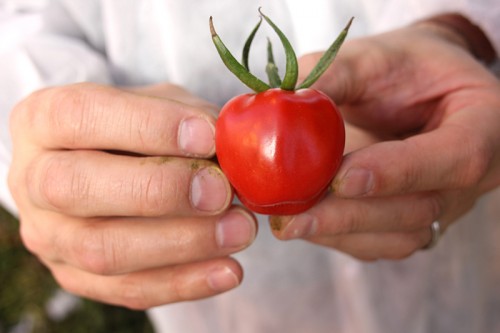
We put in the foundation posts in December 2014, we planted August 1—planting in our terms means those one-foot plantings in the stone wool—and about eight weeks later you have your first tomatoes. We had our first harvest event in October, where we welcomed all the friends we’ve been working with.
Did you ever consider building it in the Chicago area? Because obviously there’s a lot of activity with urban farms in Chicago right now.
We looked at it—one of the things is that it’s difficult to find this much land available contiguously. One of the other issues is that when you do find that much land, a lot of times they’re brownfield sites, and even though we don’t actually grow in the ground, once you take them over there’s all kinds of remediation issues that belong to you now.
The other thing, quite frankly—and I’m as big a fan of Chicago as anybody—but working with the city of Rochelle, from the moment we contacted to the moment we began construction, they would always have all the stakeholders at monthly meetings, whether it was the water department, roads, city inspectors—anybody they had would all be at the table at the same time. Anybody who’s ever done a project with the city of Chicago knows that for whatever reason, it’s a fairly Byzantine process. Especially on open land at this scale. We wanted the ability to go to phases two, three and four, and that just didn’t exist in the city.
We’re definitely open to it—I think once we establish ourselves, and we’re a little bit smarter about our business and the market, we’re open to the possibility, even if it’s just a smaller facility for demonstration purposes. It would be great to be able to take schoolkids on a bus to see a next generation greenhouse.
So the first thing you think looking at a building like this is, there’s a lot of power and other resources going into growing something that grows in the sun for free in the summer. How energy-efficient and sustainable is this kind of facility?
I mentioned how we reclaim water from the roof—you’ve been reading about water issues out west, I’m sure. One of the great things about a greenhouse like this is that it uses 10% of the water of field-grown tomatoes. Not only are we capturing all the rainwater and snowmelt off the roof, but the process itself uses only 10% of field-grown tomatoes. So it’s a very sustainable thing. In phase two, which will happen in a couple of years, we’re looking to do combined heat and power and other ways of keeping our energy consumption as sustainable as possible. So using a boiler-combustion process to create electricity as well as the heat and CO2, and then selling the excess power back to the grid.
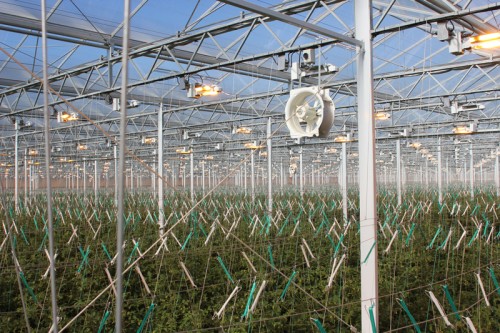
At our current size it doesn’t make sense economically, but we’ve talked to the city of Rochelle and our power folks about doing it if we move on to a phase two, which would be essentially a doubling of our current size. Ultimately, we have the land to build four greenhouses like this one, side by side.
It was a big risk, obviously, building all this before you had tomatoes to taste. Were people willing to get on board without a product to sample?
The early one on board really supporting this project was Whole Foods, who were really elemental in giving us the support early on, saying it’s about time Chicago had a local tomato, great work. They’ve been great, and Jewel’s also been an early supporter. We’ve since then branched into a number of other retailers, where we’re selling into SuperValu, which distributes into a number of banners in downstate Illinois, County Market, we’re selling into Treasure Island in Chicago, Hy-Vee.
It’s not so much a factory environment as controlled agriculture. We’ve always had a very human cultural element involved in agriculture.
We’ve got a great reception from restaurants, too. Rick Bayless and other notable chefs in Chicago have posted on social media without any urging from us how much they love the tomatoes. We’re on more and more menus—Monteverde, Cantina 1910 and others are putting us on their menus, and we’re working with other restaurants to have that identified, so that when a consumer tastes a great tomato dish, developed at the hands of a great Chicago chef, they know they can go in the supermarket and buy the same tomatoes and try their hand at the same dish.
We want people to know that, maybe in late summer your grandmother’s backyard tomato is better, but other than that, we’ve got the best-tasting tomato in town. So our focus now is on getting it into the mouths of as many consumers as possible, so they’re demanding it year-round and we can compete the whole year. We’re doing demos at Whole Foods, at the Evanston Farmers Market and other farmers markets this spring—because farmers markets open at Memorial Day, but they really don’t have any decent tomatoes until late July, August.
But you can’t do Green City Market because you’re not certified organic.
Green City we’re working on, we’re going to try to get them to come out for a tour and hope that they’ll see that although it’s not certified organic, in some ways it’s better than organic. Organic has become this label that you see applied to big factory farms in California. They’re producing organic, but they have their own issues. People think organic means no pesticides—no, it means natural pesticides. Well, there are plenty of natural poisons that I wouldn’t want to lick. I think the product we’re offering meets or exceeds a lot of the organic and sustainability requirements people are looking for in agriculture today.
Okay, but local food has sold this image of the flinty-eyed, creased-face small farmer plucking his crop from the ground of the Kankakee plain. And we’re here in this vast technological spaceship of a greenhouse. What would you say to someone who said a facility like this was a violation of the spirit, if not the letter, of local food?
I think local food is what you make it to be. I think the fact that we are located so close to the Chicago market, we’ve obviously minimized the food miles to the store. We’re supporting jobs in local agriculture, which is part of what the local food movement is about. We’ve got 35 folks working here full time—some of them have the kind of crinkly faces you’re looking for. The tomatoes are certainly all handpicked, they’re not robotically harvested.
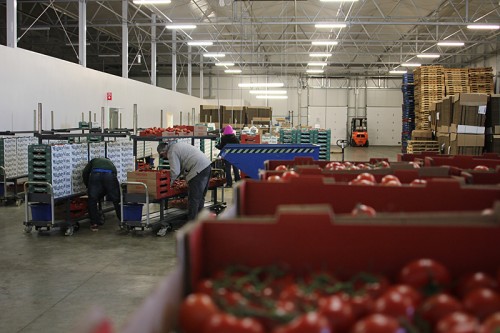
Packing room
Essentially the only difference is that we’ve got some windows above, so we can provide delicious tomatoes to Chicago in the winter. And we’re not growing in the soil, so we can better control the nutrient uptake—and as I said, we use 10% of the water intake as field-grown. So you need to balance the perceived artificial aspects—there’s nothing artificial. As you can see there’s bees buzzing around our heads right now. The tomatoes are perfectly natural, they’re not growing in petri dishes, they’re growing in a medium that’s almost exactly like soil, except that it’s not. The roots take purchase, the nutrients all come in the same way they would. You don’t have all those nutrients washing into the water table, like they would with field-grown, and ending up in the Mississippi Delta.
You need to take a balanced look if you’re the consumer. Ultimately for us, too, it’s flavor. We’re not producing these in a factory. It’s not so much a factory environment as controlled agriculture. You’re trying to do what man has always done throughout history, from when they first grew things, to when they started grafting things. We’ve always had a very human cultural element involved in agriculture. It’s not like these things grow wild, they’re all domesticated plants. It’s not that alien, which is why we like to get people out here for tours. Anybody who feels it’s artificial, I’d be happy to have them out here, take them for a tour, have them pull a tomato off a vine—and then they can make their decision.
Michael Gebert maintains a constant climate as editor of Fooditor.
Latest
Join the Discussion
After you comment, click Post. If you're not already logged in you will be asked to log in or register with Disqus.














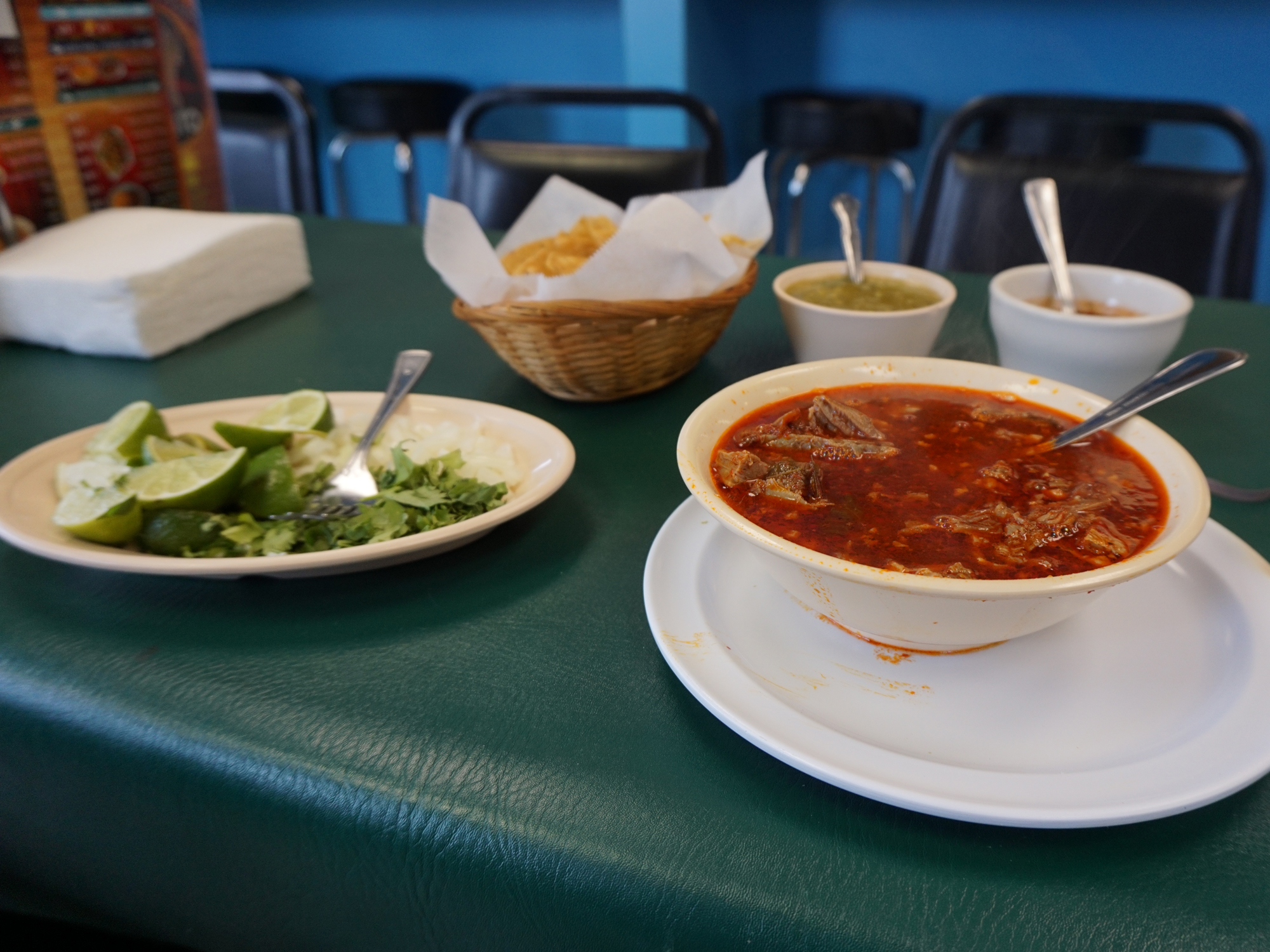
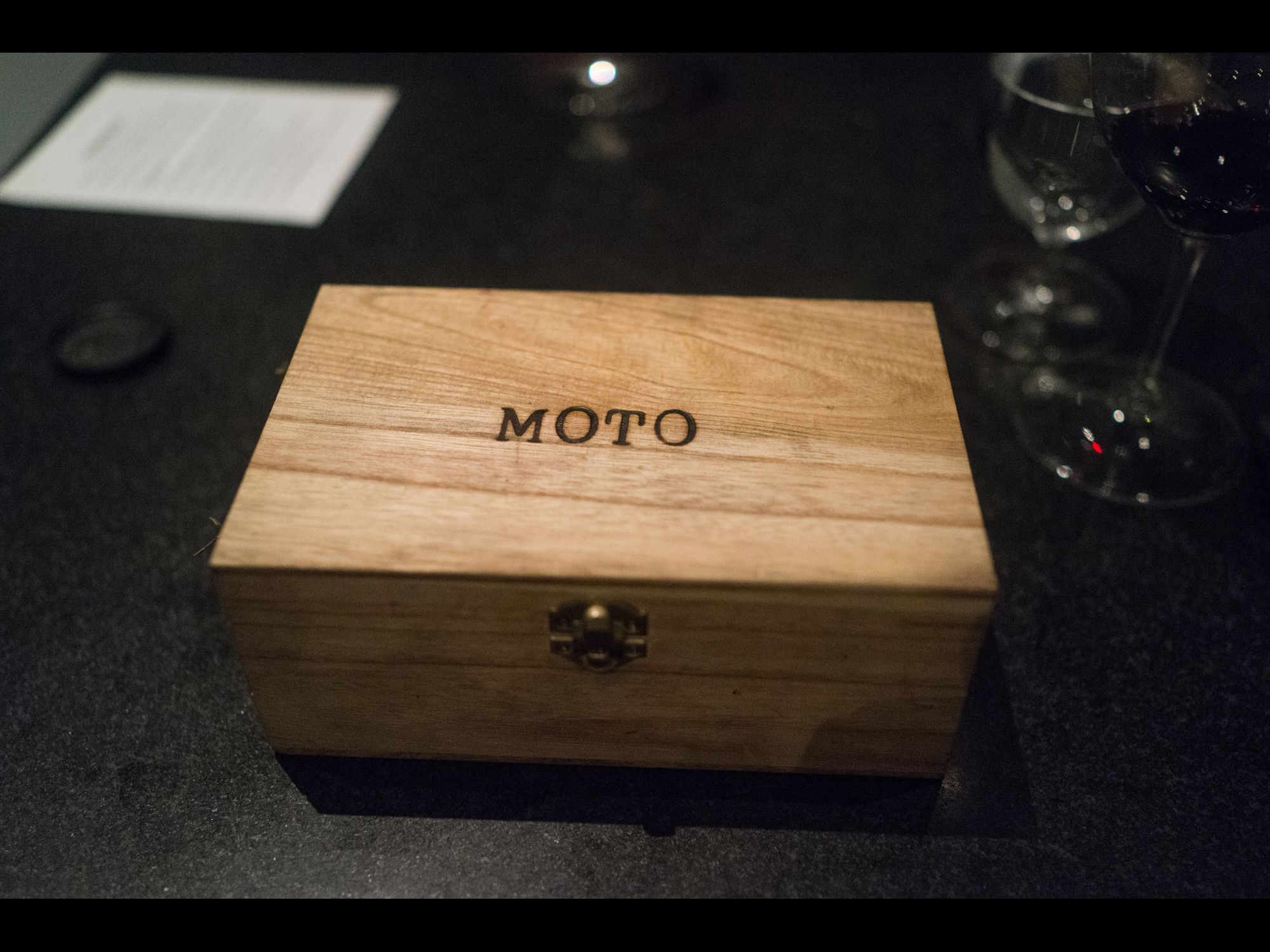
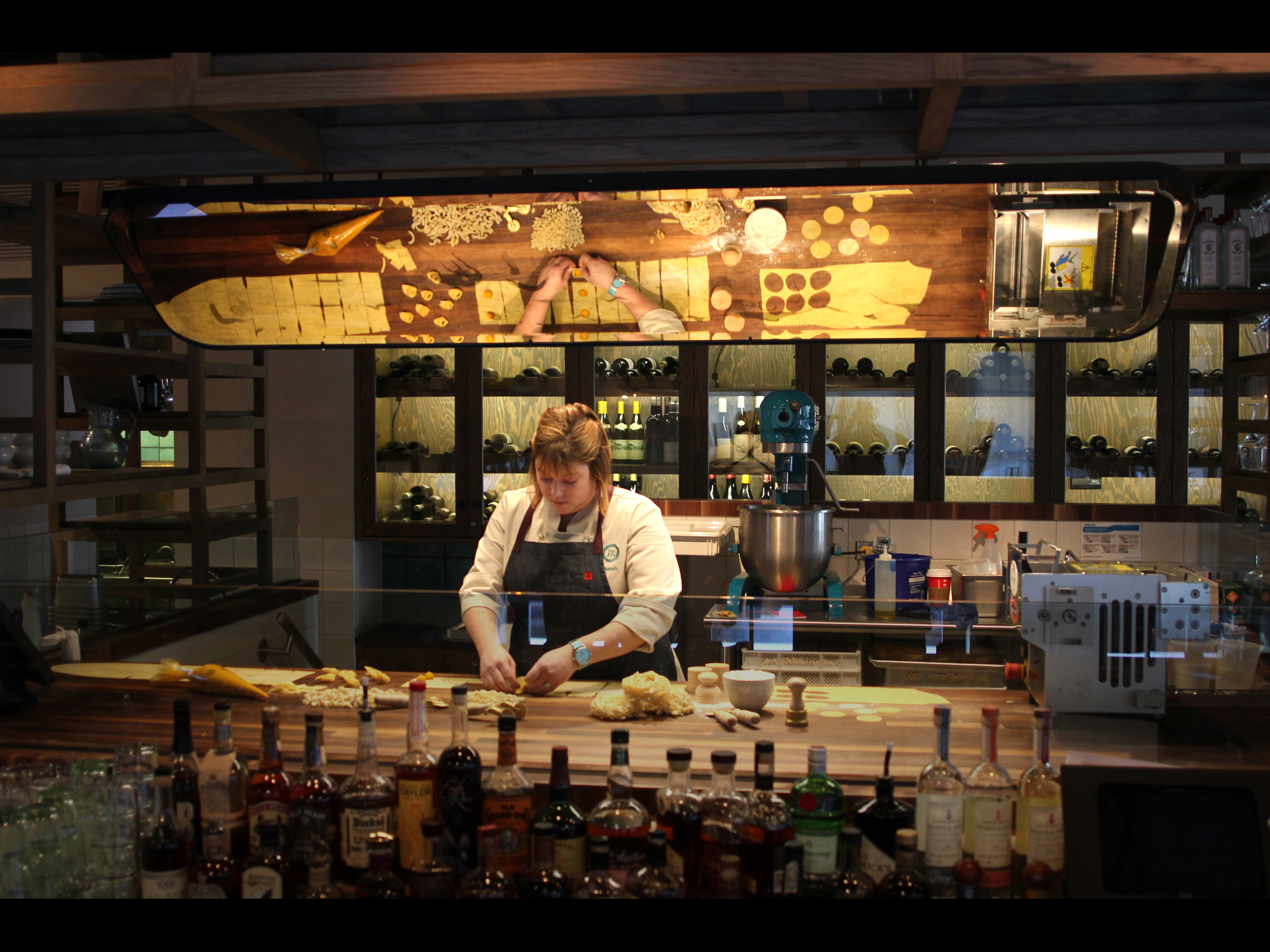
[…] Tomatoes grown in Roselle in winter? Yes—inside a seven-and-a-half acre building. Fooditor profiles MightyVine. […]
[…] Tomatoes grown in Roselle in winter? Yes—inside a seven-and-a-half acre building. Fooditor profiles MightyVine. […]
[…] Tomatoes grown in Roselle in winter? Yes—inside a seven-and-a-half acre building. Fooditor profiles MightyVine. […]